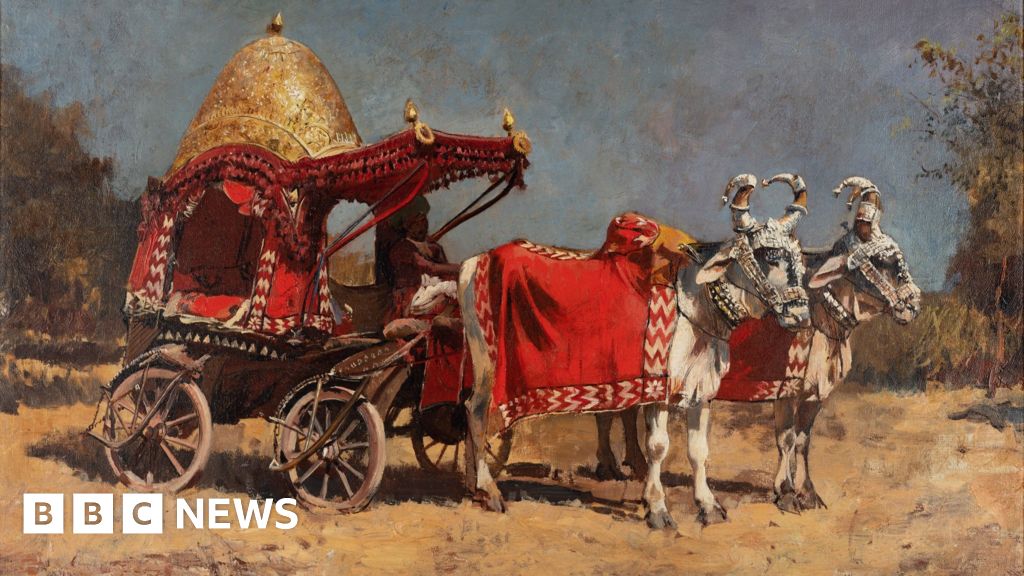By Sudha G Tilak, Delhi
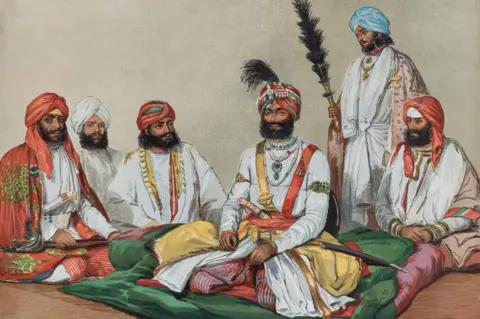 DAG
DAGA brand new exhibition in Delhi showcasing uncommon artworks by European artists offers insights into how the British dominated the nation.
Referred to as Vacation spot India: Overseas Artists in India, 1857-1947, the present focuses on artists who travelled to colonial India from world wide.
The illustration of India by way of the European and British artists has “lengthy been a topic of intrigue and exploration”, writes Indian MP and writer Shashi Tharoor, in an introduction to the present.
“The fascination with India’s distinctive landscapes, grand monuments, vibrant traditions and wealthy historical past has drawn many to its shores, searching for to seize the essence of this multifaceted nation.”
Mr Tharoor notes that the present is “refreshing and important” because it explores the less-explored, but a compelling interval of the late Nineteenth and early twentieth centuries, relatively than simply the early pioneers.
The exhibition showcases artworks, together with from British artist William Carpenter, that give glimpses into not solely the royal courts, but in addition every day life within the Empire.
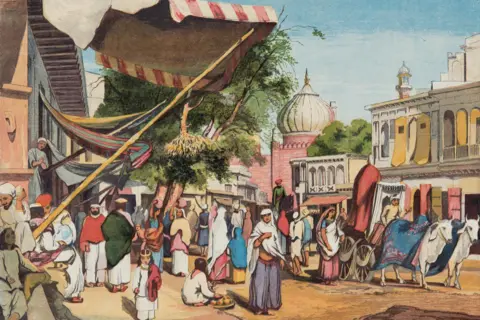 DAG
DAGCarpenter normally did watercolour, however this 1857 art work, pictured above, is wooden engraving on paper that depicts the busy again streets of Delhi’s Jama Masjid (mosque).
Many fascinating artists visited India from England and different European international locations within the late Nineteenth and early twentieth centuries. They had been primarily standard artists working in oil and watercolour and varied print media.
“They had been interested in the individuals, and never simply to the grandees, however to extraordinary individuals within the streets. If there was nonetheless a component of the picturesque, it was a extra intimate and animated model of that aesthetic,” says Ashish Anand, managing director of DAG, a number one artwork agency which has put collectively the present.
“Of their works we discover an India – if we are able to put it this manner – that we don’t simply see, however that we are able to hear and scent.”
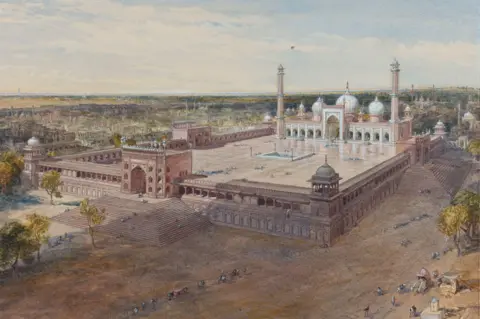 DAG
DAGThe work above is one other watercolour portray of the Jama Masjid by William Simpson in 1864.
Primarily a battle artist, Simpson was despatched to India in 1859 by a publishing firm as an example the aftermath of the violent rebellion two years earlier. Indian troopers, often known as sepoys, had in 1857 set off a insurrection in opposition to the British rule, sometimes called the primary battle of independence.
Simpson’s undertaking halted when the publishing firm went bankrupt. He known as it the “largest catastrophe of my life”. Nonetheless, he continued travelling and sketching his expeditions throughout the sub-continent.
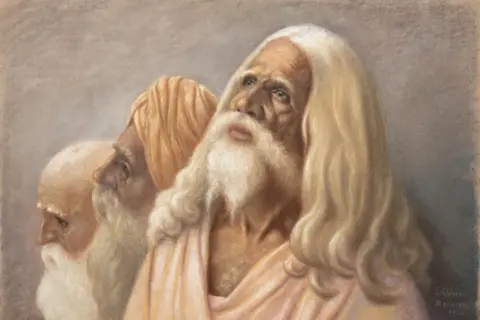 DAG
DAGThis can be a 1900 pastel portrait of aged Indians by Olinto Ghilardi, an Italian artist.
A major European artist, Ghilardi formed fashionable Indian artwork within the early twentieth Century.
He mentored Abanindranath Tagore – nephew of Nobel laureate Rabindranath Tagore and founding father of the Bengal Faculty of Artwork, which formed fashionable Indian portray. Ghilardi inspired him to experiment with watercolours, gouache, and pastels, which he extensively used later in his work.
Ghilardi additionally served because the vice principal of the Authorities Faculty of Artwork in Calcutta (now Kolkata).
 DAG
DAGThis 1896 portray of a younger Indian lady was additionally made by Ghilardi.
Not a lot is understood concerning the lifetime of the Italian painter earlier than he arrived in Kolkata. His affiliation with Tagore signifies his acceptance as an artist amongst Kolkata’s Bengali elite.
A lot later, in 1911, Ghilardi grew to become a distinguished member of an avant-garde group of Italian artists.
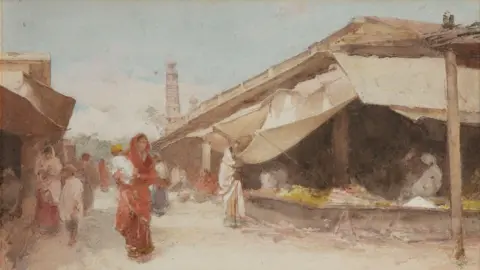 DAG
DAGThat is British artist Carlton Alfred Smith’s undated watercolour portray of a road scene in India.
Smith lived in India between 1916 and 1923. He usually painted landscapes together with portraits of individuals.
A painter of the late Victorian interval from Camden City in London, Smith started as a lithographer earlier than switching to portray. A member of the Royal Academy of Artwork, he is recognized for drawing interiors of cottages and the English countryside.
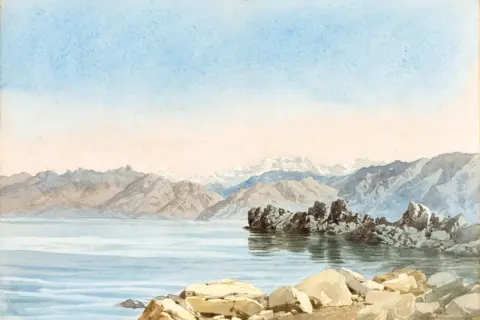 DAG
DAGThis can be a 1894 watercolour portray of Kashmir’s Wular Lake by George Strahan, a British military engineer and artist.
A gifted scholar from Surrey, Strahan joined the military and arrived in India in 1860, working in cities of Roorkee and Haridwar.
Two years later, he joined the Topographical Survey of India and began mapping central India, Rajasthan and the Himalayas.
In 1888, he grew to become superintendent of the Nice Trigonometrical Survey, which mapped the Indian subcontinent.
On the Survey, Strahan drew aid maps earlier than color printing was launched.
After retirement, he lived within the hills of Dehradun and travelled to Kashmir each summer time.
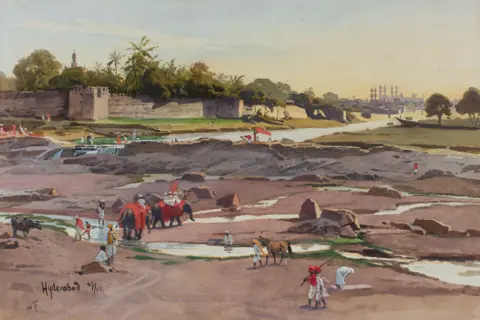 DAG
DAGThat is an 1887 watercolour of Hyderabad in southern India by German artist Woldemar Friedrich.
A historic painter and illustrator, Friedrich spent a lot of his profession instructing at prestigious German artwork academies. Within the late Eighties, he travelled to India and created a sequence of landscapes and illustrations, printed within the 1893 guide “Six Months in India”.
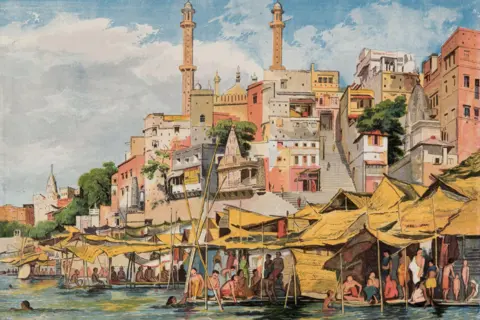 DAG
DAGCarpenter’s 1857 wooden engraving on paper art work on Benaras (above) reveals Varanasi – one of many world’s oldest cities and and India’s non secular capital – brimming with life.
Skilled on the Royal Academy Faculties in London, Carpenter grew to become a famend Nineteenth-Century portrait and panorama painter.
Arriving in India in 1850, he travelled extensively, portray rulers, road scenes, landscapes, and locals throughout Bombay (now Mumbai), Rajasthan, Delhi, Punjab, Kashmir, Lahore, Ceylon (Sri Lanka), and Afghanistan.
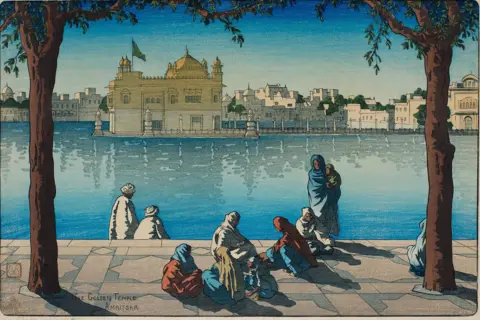 DAG
DAGThat is English artist Charles William Bartlett’s 1919 woodblock print on paper rendition of Punjab’s Golden Temple, a sacred shrine for Sikhs.
Dover-born Bartlett was one of many world’s main Japanese woodblock painters, and later switched to superb artwork.
In 1913, he travelled to India, Indonesia and China. He designed 38 woodblock prints for his Japanese writer from 1916 to 1925, together with many scenes from his travels in South Asia.
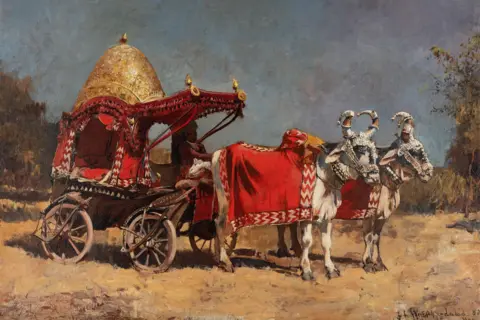 DAG
DAGAmerican artist Edwin Lord Weeks painted this vibrant oil on canvas of a bullock-cart in Ahmedabad, Gujarat, in 1882.
Born in Boston to a rich household, Weeks was among the many first American artists to go to India. His enterprise household supported his creative endeavours.
Weeks first travelled to India between 1882 and 1883, portray locations primarily in Rajasthan. He returned in 1886, when he visited at the least seven cities. Identified for his realist type and a spotlight to element, Weeks additionally wrote a journey account of his journeys by way of Persia (current day Iran) and India in 1896.

